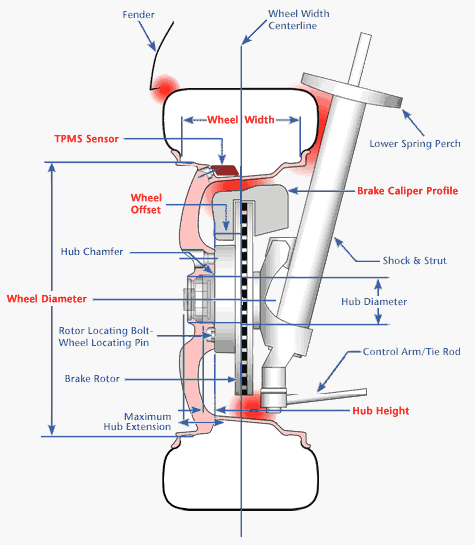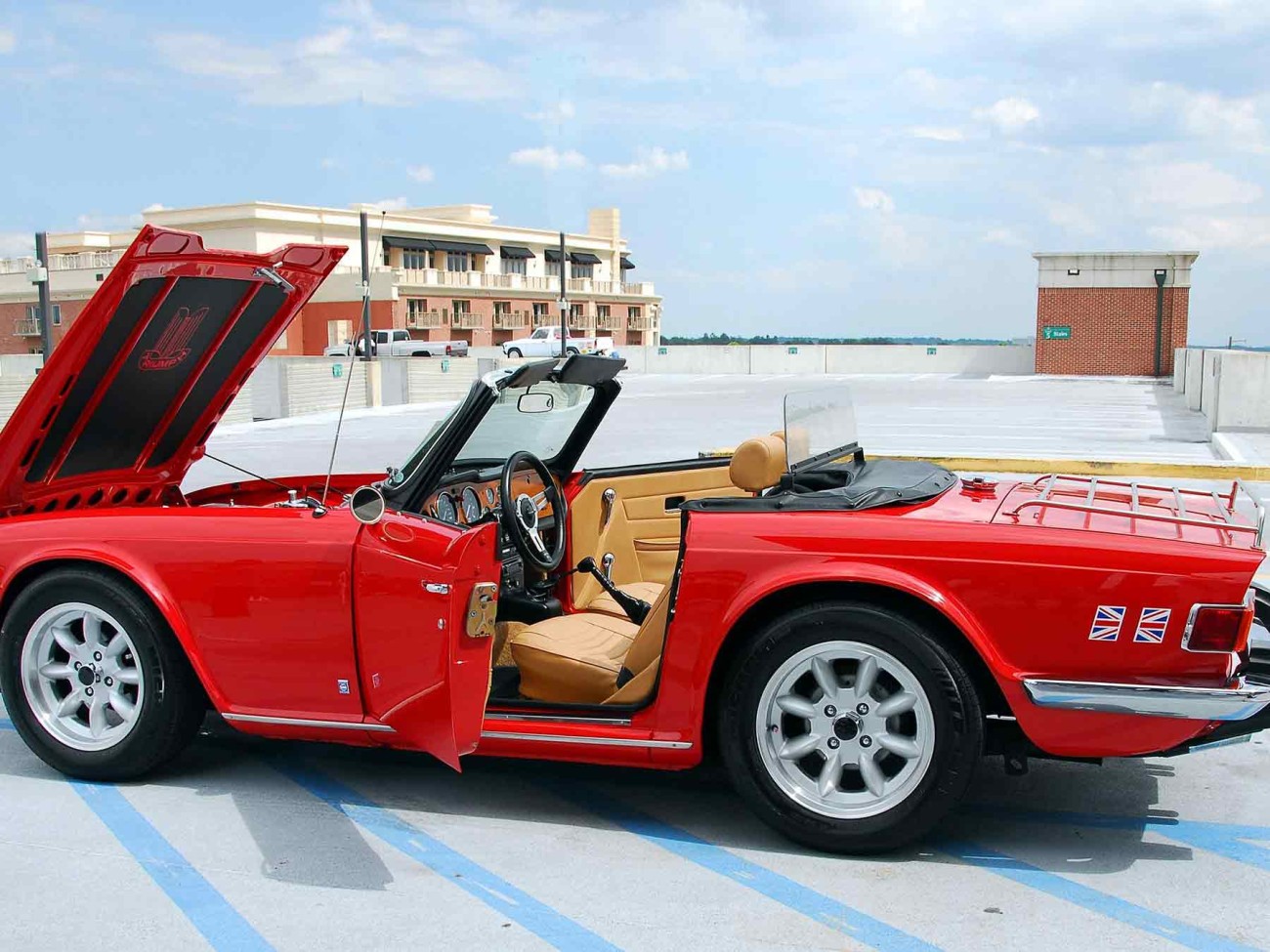Before you want to buy the right size wheel spacers, if you don't know anything about offset, etc., wheel size, tire size, and code, you need to read some information first.

offset
ET = the offset of the wheel. Usually, these two digits are usually printed somewhere
On wheels. Please refer to the figure above to understand how Et is measured. The offset of a wheel is the distance from its hub mounting surface to the centerline of the wheel. A higher ET will make the wheels inward, and a lower ET will make the wheels outward. The offset can be divided into three types.
Zero offset
The mounting surface of the wheel hub is flush with the centerline of the wheel.
Positive offset
The mounting surface of the wheel hub faces the front or side of the wheel. A + ET The wheel hub mounting surface faces the front (outer side) of the wheel. Positively offset wheels are often found on front-wheel drive cars and newer rear-wheel drive cars. +ET The wheel hub mounting surface is on the front side (outside) of the wheel.
Negative offset
The wheel hub mounting surface faces the back of the wheel center line or the brake side. The "deep plate" wheel usually has a negative offset.
As long as the wheels don't stick out of the edge of the fender or rub the internal fender or suspension components well, then you can start using it.
Only by purchasing wheel gaskets from a reputable company (such as ECCPP) can you be confident that the wheel gaskets provided for your vehicle are designed, manufactured, and manufactured for your specific vehicle.
Tire size
Such as 225/50R16 92V
The first number 225 is the cross-sectional width of the tire in millimeters.
The size is measured from sidewall to sidewall, that is, at the widest part of the tire
Point (raised to raised). The second number 50 is the aspect ratio. This is a ratio
The difference between the height of the tire and the height of the sidewall of the tire. Think of it this way: the first
Dimension (225), / (divided by) the second dimension is expressed here as a ratio
Or the fraction of the first dimension. Of course, 16 is the diameter. R stands for radial, the method of construction of the tire. As shown in the figure, the number 92 is the rated load, and the letter after it is the rated speed. Together these two are called service descriptions.
MKIV wheel information
For MKIV.
Bolt pattern 5x100
Inventory offset +35 e.t.
hub bore 57.1mm
Diameter-15" to 18"
Wheels usually need to have the correct bolt pattern, offset, and hub bores to fit the car.
Shims can be used to change the offset of the wheel. By bolting between the wheel and the hub, they push the wheel further "outward" from the car. The offset of the shim minus the wheel setting. Therefore, if you want to use et 55 offset wheels (popular OEM Porsche applications), you will need 15 or 20 mm spacers to finally get an acceptable offset (et40 or et 35).
Generally speaking, there is a lot of room for offset. The inventory is 35, but depending on the width of the wheel, you can be lower or higher than this value. Also, there is a significant difference between what you can get rid of at the front (narrower) and at the back (wider).
Bolt Pattern-The Bolt Pattern can be changed by using an adapter. Adapters use stock model (5x100) bolts to the wheel hub and provide another model of studs (for example, modern Porsche's 5x130). Because the bolt heads used to bolt the adapter to the hub must be completely embedded in the adapter itself, the wheel adapter is usually very thick (~25 mm or more). If you want to use a Porsche wheel with an initial offset of 55 (reduced to 30 with an adapter), this works well, but it does not work well for non-TT Audi wheels (bolt pattern is 5x112, inventory offset is 35). H&R manufactures bolt pattern wheel adapters in several popular combinations.
Hub bore The hub bore is the diameter of the center hole of the wheel. This hole fits the central protrusion on your wheel hub. Since the wheel is centered on the hub, it is called the hub center. Since manufacturers use different hub bores, aftermarket wheel manufacturers usually do one of two things. Both involve making the hub bore relatively large. In the first case, the wheel manufacturer makes the hub bore larger so it is suitable for various automobiles and then provides the hub ring, which is installed in the hole and adapts to the size of the hub protrusion on various automobiles. In this way, they can manufacture/store 25 different hub rings instead of 25 different wheels. The "one size fits all" wheel, plus the correct ring makes the wheel of a particular car centered on the hub. Another option is to leave the hub bore large instead of supplying the ring. In this case, the wheel becomes centered on the hub because the wheel is not centered on the hub, but on the hub nut/bolt. The Lugcentric wheel is more difficult to the center than the hub centric wheel because it is not centered on the central projection. For this reason, lug centric wheels are more prone to vibration and shimmy at speed, but if they are installed correctly, lug centric wheels can have no problems.
Wheel bolts-Stock wheel bolts are 14x1.5x28 (wire diameter x pitch x length). Longer wheel bolts are required for joints or spacers (ie, 20mm spacers require 28+20 = 48mm bolts). Stock wheel bolts are ball seats, which means they are a bit rounded. Most aftermarket wheels use tapered seat wheel bolts. You must use the correct type for your wheels or they will exit.

You should now be able to put yourself into one of two categories, you already have a wheel/tire set you want to separate, or you don’t.
If you have a wheel/tire setup, you want to leave the room. This requires tires to be mounted on wheels, and wheels to be mounted on cars. First, lay the car horizontally to the left and right. This can be easily achieved by simply measuring from the ground to the highest point of the fender. In theory, cars should be placed side by side, but usually, they are not. Just lift up the low side in small increments until the measured values on both sides are equal.
Get a plumb weight now (you don’t need anything more beautiful than a rope with a nut or washer on the end.
Stick the plumb on the centerline point of the fender (choose tape), wait until it stops swinging, and then simply measure from the outer edge of the tire sidewall to the rope. Convert this measurement to millimeters, which is the size gasket required for the tire to be flush with the fender. If you want to poke or stuff, add or subtract to get the desired width.
Dimension a is the size of the gasket required to make the tire flush
If you don’t have a wheel or tire setting
You can still calculate the size of the gasket you need, but I suggest you wait until you get the new settings, and then follow the instructions above, because it is simpler and more accurate, and you can use the "A" measurement value to imagine more What happens to the larger size of the gasket or the smaller the gasket looks like.
If you can’t wait because you are impatient, take out your calculator.
First, remove the wheel from the side of the car at the desired end (the front and rear are separated). You need to level the car. Measure from the ground to the highest point of the lip of the mudguard and make sure that both sides are the same. If not, just raise or lower the jack to make them equal. One thing to note, in the front of the car, especially on a lowered car, because you have an independent suspension, you may have to put the rotor on the ground to level the car, this is because the suspension does not Cars compressed by weight. If you need to place the rotor on the ground, just place a piece of wood under it and let the ground compress the suspension. But make sure that most of the weight is on the jack.
Now make a plumb like the one above and glue it to the centerline of the fender. When the plumb weight is stabilized, measure from the wheel mounting point on the hub (not the place where the brake disc or the lug bolt is screwed in) to the rope. Pay attention to this dimension.












